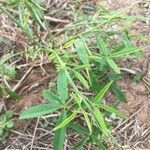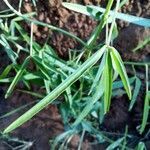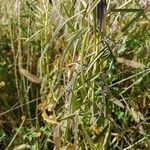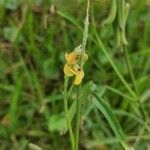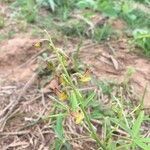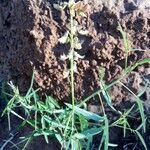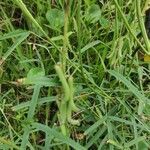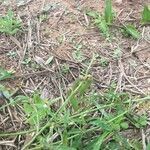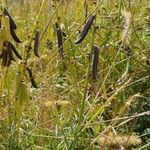Erect annual, up to 8–17 dm. tall, laxly branched.. Stem ribbed, appressed puberulous or rarely shortly spreading pubescent.. Leaves 3-foliolate, rarely some of the upper ones 1-foliolate; leaflets mostly linear to lanceolate, but the lower ones sometimes elliptic, up to 40–105(–170) mm. long, 3–17(–22) mm. wide, glabrous or very rarely hairy above, thinly covered with appressed hairs beneath; petiole up to 20–80 mm. long.. Stipules absent.. Racemes up to 8–35 cm. long, with many fairly closely arranged flowers; bracts subulate or filiform, expanded at the base, 1–3 mm. long; bracteoles inserted at the base of the calyx, narrow, up to 1 mm. long.. Calyx becoming basally truncate and deflexed against the pedicel, 3–4 mm. long, appressed puberulous, usually thinly so; lobes subulate or acuminate, shorter than the tube.. Standard broadly elliptic or suborbicular, yellow, veined reddish-purple and glabrous outside; wings shorter or longer than the keel; keel rounded about the middle, with an incurved or projecting untwisted beak, 6·5–11 mm. long.. Pod subsessile, narrowly cylindrical, (22–)24–35 (–40) mm. long, 4–6 mm. across, appressed puberulous, 24–50-seeded.. Seeds oblique-cordiform, ± 2–3 mm. long, smooth, pale yellow to orange-brown.
Herbs, 50-100 cm tall. Branches terete, pilose when young but glabrescent. Stipules absent. Leaves 3-foliolate; petiole 3-6 cm; petiolules 1-2 mm; leaflet blades linear to linear-lanceolate, 5-9(-12) × 0.5-1 cm, both surfaces sparsely pilose or glabrous, base cuneate, apex acuminate and mucronate. Racemes terminal, to 20 cm, 10-40-flowered; bracts subulate to filiform, 0.5-3 mm, expanded at base. Pedicel 3-5 mm; bracteoles normally inserted at base of calyx or rarely on pedicel, narrow, 0.3-1 mm. Calyx subcampanulate, ca. 3 mm, 5-lobed, pubescent; lobes triangular, shorter than tube. Corolla yellow, exserted beyond calyx; standard broadly elliptic to orbicular, ca. 1 cm in diam., base with 2 appendages; wings oblong, ca. 1 cm, marginally pilose at base; keel ± as long as wings, apical half rounded, marginally pubescent at base, beak long. Ovary subsessile. Legume oblong, 2-3 × 0.5-1 cm, many seeded, glabrous. Seeds obliquely cordate. Fl. Jun-Aug, fr. Sep-Nov.
Erect, laxly branched, annual herb, 0.2-1.7 m high; branches ribbed, young parts covered with very short, appressed hairs. Leaflets mostly linear-lanceolate, 40-100 (-170) mm long, thinly appressed puberulous beneath; petioles shorter than leaflets. Stipules lacking; upper leaves sometimes unifoliolate. Inflorescences many-flowered racemes, 80-350 mm long. Flowers yellow, veined reddish purple. Calyx becoming deflexed against pedicel, thinly appressed puberulous; lobes usually shorter than tube. Petals: keel rounded about the middle, with incurved or projecting beak. Pod subsessile, narrowly cylindrical, often incurved at tip, appressed puberulous, 16-38 mm long. Seeds oblique-cordiform, smooth, pale yellow to orange-brown.
A stiffly erect bush. It has few branches. It has a few soft hairs. The leaf stalk is slender and almost straight. It is 4 cm long. The leaflets are 8 cm long by 1 cm broad. The flowers are on stalks on the top of the plant. The small flowers are well spaced along a 20 cm long stalk. The flowers are yellow. They are 1 cm long. The fruit is a pod. It is dark and hangs down. It is 3 cm long by 5 mm wide.
Leaves 3-foliolate (rarely a few of the uppermost 1-foliolate), estipulate; leaflets mostly 4–11(17) × 0.3–2(3.5) cm, usually predominantly linear-lanceolate to lanceolate, the lower ones sometimes elliptic, but sometimes (particularly subsp. exigua) all elliptic-oblong to elliptic, thinly appressed puberulous beneath, rarely also above; petiole shorter than the leaflets.
Erect laxly branched annual or short-lived perennial, 0.2–1.7 m tall; branches mostly ascending, lower ones sometimes spreading, ribbed, covered at least when young with short appressed or rarely slightly spreading hairs.
Standard broadly elliptic to subcircular, yellow, veined reddish-purple outside; keel 5–11 mm long, rounded about the middle, with an incurved or projecting beak.
Calyx 2–4 mm long, becoming basally truncate and deflexed against the pedicel, puberulous; lobes subulate to triangular-acuminate, usually shorter than the tube.
Racemes up to 8–35 cm long, many-flowered; bracts 0.5–3 mm long, subulate or filiform, expanded at the base; bracteoles at the base of the calyx, 0.3–1 mm long.
Pod (1.6)1.8–3.8 × 0.4–0.6 cm, subsessile, cylindrical, sometimes curved up at the tip, appressed puberulous, 20–50-seeded.
Seeds 2–3 mm long, oblique-cordiform, smooth, pale yellow to orange-brown.
